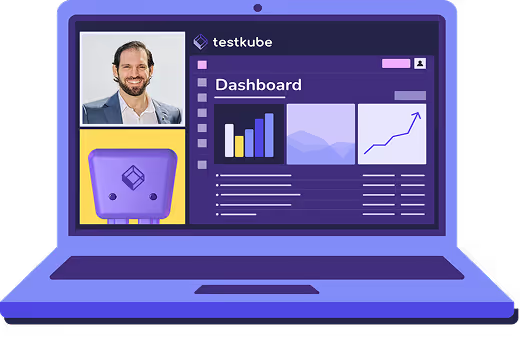Table of Contents
Definition
While Postman is excellent for defining and validating API behavior, it is not built for full-scale performance testing. Testkube extends Postman into a Kubernetes-native performance testing solution, enabling scalable execution, observability, and orchestration across distributed environments. Other tools like JMeter, k6, and Gatling can complement Postman when deeper load simulation or specialized analytics are needed.
Why It Matters
Most teams start their API lifecycle in Postman, but as systems grow, simple request validation is not enough. Modern architectures require continuous performance verification under real-world load conditions. Testkube bridges this gap by letting you reuse your Postman collections as part of automated, cluster-native test workflows. This allows teams to validate performance early, continuously, and at scale, without abandoning the simplicity of Postman.
How It Works
Testkube integrates directly with Postman collections to execute them as part of Kubernetes-managed test workflows. This unlocks capabilities that extend far beyond what’s possible with Postman alone:
- Native Kubernetes Integration: Run Postman collections directly within your Kubernetes clusters.
- Parallel and Distributed Execution: Scale load generation horizontally across namespaces or clusters.
- Unified Observability: Aggregate logs, metrics, and results from every Postman test in one place.
- CI/CD Compatibility: Trigger tests automatically from Jenkins, GitHub Actions, or GitLab pipelines.
In this setup, Testkube becomes the execution and orchestration layer, while Postman remains the familiar interface for defining requests and assertions.
Real-World Examples
- Enterprise-scale testing: A platform team runs Postman collections as Testkube test resources across multiple Kubernetes clusters, validating API performance for every new microservice deployment.
- CI/CD integration: A DevOps team uses Testkube to trigger Postman performance tests after each build in GitHub Actions, storing results centrally for observability.
- Load testing evolution: A QA team converts Postman collections into k6 scripts for stress testing and orchestrates them via Testkube for distributed execution.
Key Benefits
- Reuse Postman collections for true performance and scalability testing
- Automate testing directly inside Kubernetes environments
- Eliminate environment drift between local, staging, and production
- Gain centralized observability of results and system behavior
- Integrate seamlessly with CI/CD pipelines and GitOps workflows
How It Relates to Testkube
Testkube is the primary solution that transforms Postman from a local testing tool into a production-grade continuous testing system.
- Native Execution: Testkube runs Postman tests as Kubernetes workloads, letting you scale to match real production load.
- Unified Control Plane: All Postman test runs, results, and metrics are managed through the Testkube dashboard or CLI.
- Cross-Environment Consistency: The same Postman tests can be executed locally, in CI, or across clusters without modification.
- Scalable Load Simulation: Testkube supports concurrent execution of Postman collections, making it easy to stress test distributed systems.
- Observability and Analysis: Every test execution generates logs and metrics accessible from one centralized location.
This approach makes Testkube not just a complement, but the logical evolution of Postman testing for teams operating in modern, Kubernetes-powered environments.
Other Complementary Tools
While Testkube covers orchestration, scalability, and observability, other tools can complement your performance testing ecosystem:
Common Pitfalls
- Treating Postman’s internal performance runner as equivalent to load testing.
- Running tests from a single developer machine, creating inconsistent performance data.
- Overlooking cluster-level visibility when tests run in distributed environments.
- Using multiple tools without a unifying orchestration layer like Testkube.
Frequently Asked Questions (FAQs)
1. Why use Testkube for Postman performance testing?
Because Testkube runs Postman collections natively inside Kubernetes, providing scalability, parallel execution, and centralized visibility, all without modifying your tests.
2. Does Testkube replace Postman?
No. Postman remains your tool for authoring and validating requests. Testkube extends those tests into orchestrated, automated, and scalable workflows.
3. Can Testkube run other performance tools too?
Yes. Testkube can execute JMeter, k6, Gatling, and many other frameworks as Kubernetes workloads, unifying results and observability under one platform.
4. How does Testkube differ from Newman?
Newman runs Postman tests in a local or CI environment. Testkube runs them at scale within Kubernetes clusters, adding orchestration, parallelization, and reporting layers.
5. What’s the easiest way to migrate Postman tests into Testkube?
Simply export your Postman collection as JSON and register it as a Testkube test using the CLI or UI. You can run it instantly in-cluster or connect it to your CI/CD pipeline.


